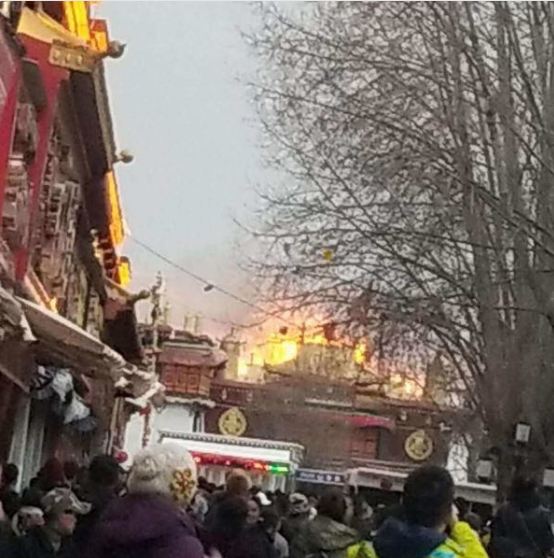
(TibetanReview.net, Feb19, 2018) – A fire, believed to be major, and suspected to have continued for at least an hour, has engulfed a part of the Jokhang Temple in Tibet’s capital Lhasa on Feb 17 evening. China’s official Xinhua news agency reported Feb 17 that the fire broke out at 6:40 pm and was soon put out, citing the official WeChat account of Tibet Daily.
Xinhua said no casualties had been reported.
Another Xinhua reported Feb 18 said the Barkhor, a bustling market street in the heart of Lhasa, was reopened to the public Sunday (Feb 18) after a temporary closure following a fire.
And the official china.org.cn reported Feb 19 that an orderly crowd of pilgrims and tourists lined up Sunday to visit the Jokhang Temple, one day after part of the sacred monastery caught fire. It added, citing Xinhua reporters, that there were are no visible signs of the fire in the areas open to the public except for some water marks in the main hall of the monastery.

The Jokhang Temple, considered the most sacred by Tibetan Buddhists, has a history of more than 1,300 years. It houses many cultural treasures, including a life-sized statue of the Shakyamuni Buddha at 12 years old.
The extent of damage to the sprawling compound was unclear. State media said there was no damage to cultural relics, noted bbc.com Feb 18.
China, while playing down the seriousness of the fire and the extent of the damage, has strictly censored new about the incident. Its official media largely carried only news put out by Xinhua.
Photos posted online showed flames ravaging part of the ancient Buddhist temple, noted nytimes.com Feb 17. It cited The People’s Daily, China’s main official newspaper, as saying online that there had been “no damage to relics” in the temple.
The report noted that the fire, having broken out at 6:40 pm local time, which was more than an hour before sunset in Lhasa, was still seen in some of the video footage burning in the dark, suggesting that the blaze had lasted an hour or longer.
The report said many of the pictures of the fire were, however, quickly taken down.
The official reports did not specify which part of the temple, spread over more than six acres, had been damaged by the fire. However, some accounts shared on Chinese social media suggested the blaze had broken out in a side hall or annex, possibly a housing area, which was not a part of the main building that Tibetans consider the heart of the Jokhang, the report noted.
However, theguardian.com Feb 18 cited Robert Barnett, expert on contemporary Tibet, as saying Beijing’s “almost total suppression of information” about the incident meant many Tibetans feared “the heart of Tibetan Buddhism” had suffered significant damage.
For almost four hours after the fire began, he was cited as saying, it was not even acknowledged by China’s heavily controlled media, “even though you could see it from miles away across the whole city”.
And the scmp.com Feb 18 cited Barnett as saying in a tweet that sources in Lhasa “claim police have threatened anyone distributing pictures or unofficial news about the fire”.
The rfa.org, citing Tibetan sources, reported Feb 17 that the fire had set at least one building ablaze but spared the central Jokhang cathedral, a major pilgrimage site. It also noted that the extent of damage to the ancient structures, religious images, and other treasures in the Tsuklhakhang compound was still unclear.
The blaze came as Tibetans across the country were celebrating Losar, the traditional Tibetan New Year that began on Feb 16, which was also the Chinese Lunar New Year, and awaited throngs worshippers.





